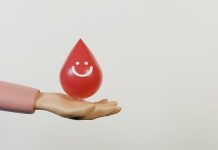
To understand our story, we need to talk about DNA. It’s like a blueprint that tells our bodies how to work.
Inside our DNA, there are things called genes that give specific instructions for everything in our body, like the color of our eyes or how tall we’ll grow.
Our DNA is made of two types: coding DNA and non-coding DNA. Imagine it like a recipe book, where coding DNA is the recipes you use, and non-coding DNA is the blank pages in between.
For a long time, people thought these blank pages, or the non-coding DNA, didn’t do anything important. They called it “junk DNA.”
Now, let’s think about blood pressure.
It’s like the force of your blood pushing against the walls of your blood vessels. When this force is too high for a long time, it’s called hypertension.
Hypertension isn’t good for us because it can cause heart problems. Over a billion people around the world have it!
The Mission: Unraveling the “Junk DNA” Mystery
Recently, scientists at a hospital called SickKids in Canada started looking at non-coding DNA. They thought that even if it’s not giving direct instructions like coding DNA, it might still be doing something important.
The team, led by a scientist named Dr. Philipp Maass, decided to investigate non-coding DNA to see if it had anything to do with blood pressure.
The Clues: Variants and Blood Pressure
In their detective work, these scientists found something interesting.
They discovered little changes in the non-coding DNA called ‘variants’ that seemed to be connected to high blood pressure. It was as if they found hidden notes in the blank pages of our recipe book!
So, the scientists decided to figure out how these variants in the non-coding DNA might be controlling genes related to blood pressure.
The Investigation: Looking at Lots and Lots of Variants
The scientists used a tool called a massively parallel reporter assay (MPRA) to look at over 4,600 variants in the non-coding DNA. That’s a lot of detective work!
Even though this non-coding DNA doesn’t make proteins like coding DNA, the scientists found that many of the variants they looked at were around genes connected to blood pressure regulation.
This means that non-coding DNA might be acting like volume control, telling those genes to be louder or quieter.
The Results: A Map of Blood Pressure Regulation
After a lot of hard work, the scientists found many clues in the non-coding DNA that might be influencing blood pressure.
It was as if they’d made a map of all the hidden notes controlling blood pressure genes in our recipe book.
This map doesn’t just help us understand blood pressure better. It can also be used as a guide to investigate other things in our bodies, like how we grow or why we get sick.
The Future: Personalized Health Care
The scientists at SickKids are excited about their discovery. They think this could be a step toward ‘Precision Child Health.’
This is a big word that means giving each person care that’s specially designed for them. Knowing about these variants could help doctors guess who might develop high blood pressure and start helping them sooner.
In the end, the team proved that even the parts of our DNA we thought were “junk” could hold important secrets about our health.
It’s a reminder that even things that seem unimportant at first glance can turn out to be very important after all!
If you care about blood pressure, please read studies about how diets could help lower high blood pressure, and 3 grams of omega-3s a day keep high blood pressure at bay.
For more information about nutrition, please see recent studies that beetroot juice could help reduce blood pressure, and results showing cinnamon could help lower high blood pressure.
The study was published in Cell Genomics.
Copyright © 2023 Knowridge Science Report. All rights reserved.



